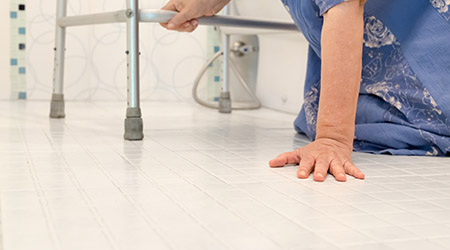When the word hospital is mentioned, certain adjectives come to mind: healing, sanitary, and pain-relief are some of the most common. While hospitals are known for all these things and more, one attribute that isn’t as well known is the risk of falls.
Between 700,000 and 1 million people in the United States experience falls in hospitals annually, according to the Agency for Healthcare Research and Quality (AHRQ). The total number of people admitted into a hospital in the United States in one year is 36,241,815, according to the American Hospital Association.
Falls are worrisome because they can result in further injury to patients. Fractures, lacerations, and more serious injuries are all things that no patient — or hospital staff — wants to experience. The good news is that research indicates that nearly one-third of all falls in a hospital setting can be prevented, according to AHRQ.
Not all falls can be prevented, no matter how diligent patients and staff are. An important tool in fall prevention though is two-fold: managing the fall risk factors of each patient and paying careful attention to the physical design of hospitals.
Russell J. Kendzior, WACH, RAS, of the National Floor Safety Institute (NFSI), says that there are key areas for hospitals to consider when it comes to flooring in facilities.
“Hospitals need to regularly measure the slip resistance of their walkways to ensure that they are slip-resistant and in compliance with the NFSI B101 walkway safety standards,” says Kendzior. “Testing should be performed per the NFSI B101.3 wet Dynamic Coefficient of Friction test method using an NFSI approved tribometer.”
Doing so will decrease the risk of falls in hospital settings.
Second, hospitals should use flooring materials and cleaning products that are NFSI certified as high traction. This certification is a hospital’s guarantee, says Kendzior, that both the floor and cleaning agents follow the standard of care and don’t present an elevated slip hazard. He says that there are currently more than 500 NFSI certified products listed on the organization’s website.
Not all flooring manufacturers test their products for slip-resistance or publish their data — even when a product claims to be slip resistant, Kenzior says. Two recent petitions to the U.S. Consumer Product Safety Commission by NFSI called for mandatory testing and labeling of the slip resistance of all flooring materials which the flooring industry aggressively opposed,” he said.
What’s a facility to do?
“The only way a hospital can know for sure that their floors are safe is to test themselves,” Kendzior says.
Joy Choquette is a Vermont-based freelance writer.

 Design Plays a Role in the Future of Healthcare
Design Plays a Role in the Future of Healthcare Cedar Hill Regional Medical Center GW Health Officially Opens
Cedar Hill Regional Medical Center GW Health Officially Opens Designing Healthcare Facilities for Pediatric and Geriatric Populations
Designing Healthcare Facilities for Pediatric and Geriatric Populations Kaiser Permanente Announces New Hospital Tower at Sunnyside Medical Center
Kaiser Permanente Announces New Hospital Tower at Sunnyside Medical Center Building Disaster Resilience Through Collaboration
Building Disaster Resilience Through Collaboration